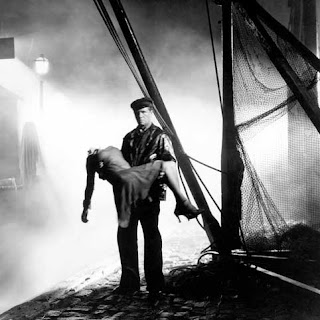THE DOCKS OF NEW YORK (Josef von Sternberg; USA; 1928)
Von Sternberg had the ability to sculpt sumptuous films from bare-bones narratives. Docks of New York is as basic as it comes. A ship's stoker, with one night on the town before leaving harbour, rescues a suicidal prostitute from drowning; on a whim (drunken for him, forlorn for her) they decide to get married; in the bright light of the next morning, he leaves her, then returns to rescue her again, this time from jail, as he takes the rap for a dress he stole for her. From this wispy story, the film billows and plumes into a magisterial work of art, largely through the use of two elements – atmosphere and facial expression.
There is a deep ambiguity in the faces of the main characters, a kind of evasiveness and unreadability that can remind a viewer of the impenetrability and difficulty in understanding the motives of others. When the stoke and the prostitute sit in a bar, drinking and eating and egging each other on into getting married, it's hard to tell why they are doing this. For Bill, the stoker, his ever-shifting expressions seem to suggest in one moment that he simply wants to bed her, in the next that a declaration of marriage is an act of defiance, in the face of god-knows-what, the next moment he seems genuinely sincere in his love for her. For Mae, the prostitute, it's hard to tell whether she really wants to get married or whether she is going through the motions, confused and exhausted and still feeling as if she has little to live for.
The scenes in the bar fill the screen with the bawdiness of drunken revelry, conveying the fleeting sensation when drunk of being in a heightened state of now where anything is possible and everything is permissible. Again, it's hard to tell the motivations of the drunken throng that cram into the frame to watch the couple getting married – are they genuinely cheering on the marriage, or are their cheers hiding a derisive attitude towards the couple?
An older married couple, Lou and Steve, act as a crystal-ball potential future for Bill and Mae. Far more apart than together, this couple's tragic dissolution embodies all the negative outcomes of a decision made on a whim – ennui, world-weariness, contempt, and hang-dog unhappiness. Again, expressions do not reveal a central truth – when Lou is helping Mae throughout the film, it is hard to tell whether she truly cares about her, wishes her to be happy, of whether she is mocking her, wishing her fate to be exactly as awful as her own. Her laughter appears to be utterly maniacal, as if she has just cursed Mae, yet in a following moment it is as if a genuine hope that things will be better for someone else struggles through her haggard facade. (A little aside – Lou was played by Olga Baclanova, noted for portraying the bad ol' bitchy trapeze artist who gets her ducky comeuppance in Freaks. Thought I recognised the demonic laughing visage from somewhere).
Grime, sweat, and poverty ooze from the pores of this film. The film glistens, with sweat and grime on the countenances of the stokers working in the ship, steam issuing from the ship, mists around the docks at night-time. The dock-side bar is packed with such bustling merrymaking that you can almost smell the stale beer. Bill remains in his wet clothes for so long you begin to feel clammy just looking at him. The room that Bill and Mae stay in, to consummate their marriage, is pockmarked, thread-bare, and spare, with gulls constantly alighting at the sill, acting as visual register for any mood pervading the room (calm for quiet moments, flighty for moments of anger).
Every moment feels as if it has been painted. Choreography and chiaroscuro are the twin engines that fuel the film's forward momentum. We spend so long shrouded in night-time hues that when day breaks, about 45 minutes into the film, the clear light of the morning seems like a sobering, cleansing revelation.
And Sternberg's choice for the final shot is mesmerising – instead of lingering on the protagonists as they part, the camera slides back out of the court, leaving Mae to be swallowed up as just another bystander in court, surrounded by the motion and friction of the continuation of daily life. This ending makes you feel as if it is not just their story anymore, but that the saga of quick feelings, conflicting emotions, flash decisions, self-serving motives, strained hope, and humble atonement, continues before, after, and around the film.


No comments:
Post a Comment